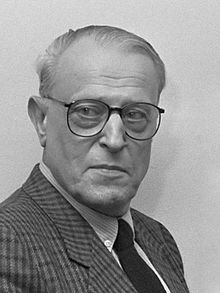Willem Frederik Hermans | |
|---|---|
 W. F. Hermans in 1986 | |
| Born | 1 September 1921 Amsterdam, Netherlands |
| Died | 27 April 1995 (aged 73) Utrecht, Netherlands |
| Occupation | Physical geographer, writer |
| Nationality | Dutch |
| Period | 1940–1995 |
| Genre | Poetry, novels, short stories, plays, essays |
| Spouse | Emmy Meurs (1950–95) |
Willem Frederik Hermans (Dutch pronunciation: [ˈʋɪləɱ ˈfreːdərɪk ˈɦɛrmɑns]; 1 September 1921 – 27 April 1995) was a Dutch author of poetry, novels, short stories, plays, as well as book-length studies, essays, and literary criticism. His most famous works are The House of Refuge (novella, 1952), The Darkroom of Damocles (novel, 1958), and Beyond Sleep (novel, 1966).
After World War II, Hermans tried to live off his writing exclusively, but as his country was recovering from the Occupation, he had no opportunity to sustain himself. He published three collections of short stories from 1948 to 1957, chief among them the novella The House of Refuge (1952), and in 1958 became lecturer in physical geography at Groningen University, a position he retained until his move to Paris, France, in 1973. The same year 1958 he broke to a wide audience with The Darkroom of Damocles.
In the 1970s, Hermans played an important role in the unmasking of Friedrich Weinreb as a cheater of Jews in the war. Hermans refused to accept the P. C. Hooft Award for 1971. In 1977, he received the Prijs der Nederlandse Letteren, the most prestigious literary award available for writers in the language, handed out every three years alternately by the reigning Dutch and Belgian monarchs to a writer of the other country, the Belgian king Boudewijn handing the prize to Hermans. Hermans is considered one of De Grote Drie, the three most important authors in the Netherlands in the postwar period, along with Harry Mulisch and Gerard Reve.[citation needed]